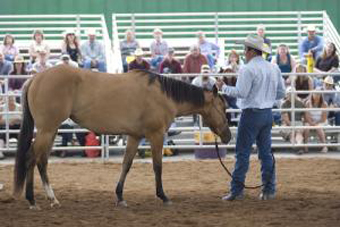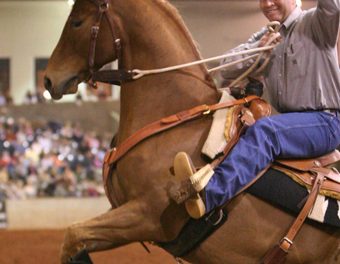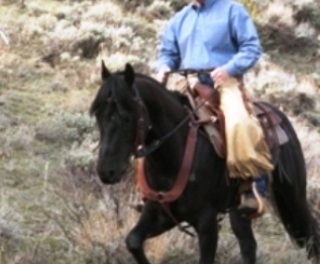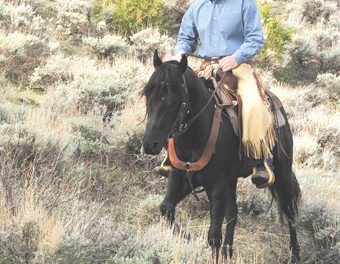 Does your horse refuse to stand for the farrier? Do you struggle to pick up and clean his feet? This month, we will cover some exercises to teach your horse to pick up his feet and stand politely and quietly while you or you farrier work with him.
Does your horse refuse to stand for the farrier? Do you struggle to pick up and clean his feet? This month, we will cover some exercises to teach your horse to pick up his feet and stand politely and quietly while you or you farrier work with him.
For these exercises, you will need a halter with a 12’ lead rope and a hammer. I prefer a rope halter and lead rope with no hardware, but whatever halter you have can work. It is important that the lead rope be 12’ in length. You don’t need a special farrier’s hammer for these exercises; any carpenter’s hammer will work.
There are two reasons your horse will fight you when you try to handle his feet: One, he is afraid of you or nervous about you handling him. Two, he thinks that you are going to take his foot away and he is not going to be able to get it back. Horses need their feet to survive. In the wild, a horse that can’t run is quickly eaten by a predator. It takes trust for your horse to allow you to pick up his foot and take away his ability to run. It is important to keep these things in mind as you work with your horse’s feet.
Begin this month’s exercise in a pen or enclosed area. I like to start by working with the hind feet, since we tend to be most nervous about them. Stand by your horse’s shoulder, facing the back towards the hind end as you would when you are getting ready to pick up his feet. Hold the lead rope in the hand closer to your horse and place your hand with the lead rope on his withers. There should not be much slack in the rope leading from his halter to your hand, but you don’t want to hold so tight that you pull his head around towards you. Hold the tail of the rope in your other hand. Start swinging the rope, letting it bump around your horse’s hind legs. Make sure the rope just bumps him and is gone quickly. This allows your horse to feel the pressure there and then gone, and builds your confidence. Once your horse stands quietly for you to swing the rope around his near hind leg, start swinging the rope around so it bumps the far hind leg as well. Use a nice, even swinging motion, and keep your hand on the withers the entire time so you stay out of kicking range. When your horse is doing well on one side, switch sides and repeat these exercises.
Next, move your body back towards your horse’s hind end. It is very important that you stand with your toes pointed out away from the horse at a ninety degree angle. That way if he kicks you your knees will just buckle in the direction they bend naturally, rather than blowing out a tendon if he were to kick you in the front or side of your knee. Stay in this position and run your hand quickly and rhythmically down your horse’s hind leg, starting at the hip. Only go a little ways down the horse’s leg at first, then work from the top of the hip again, going a little further each time until you can run your hand all the way down to the hoof. Once he is comfortable with this, pick up the leg and hold it for a split second, then drop it immediately. This lets your horse know that you want his foot, but you are not going to keep it. Now, hold it for a little longer, and let it drop. At this point you should be lifting the leg in and up towards the horse’s belly, not yet trying to bring it out in back of him. The whole time, your knees should still be pointed away from the horse as we mentioned earlier. It feels a little awkward, but is very important for your safety. Take you time with this lesson, breaking it down in to small pieces over multiple days if you want to.
Once your horse is comfortable with all the previous exercises, you are ready to move on. Pick his hind foot up, stretch it out behind him a little, and rest it on your knee like the farrier would. Ask him to let you do this for a very short time at first, and ask for longer amounts of time as he gets more comfortable. Take the end of your lead rope, and tap it on the bottom of his hoof like a hammer. Rub the rope around the hoof like a farrier’s rasp. When he is comfortable with that, take your hammer and start tapping the hoof, just like your farrier does when he is putting on shoes.
If at any point during this process your horse tries to pull away from you, hold and wait until you feel him relax, then release the foot you were holding. If he gets his foot away from you, that’s okay. Just immediately ask him to pick it up again. If he is really trying hard to take his foot away, you can longe him for a few minutes, then let him stand and rest and return to handling his feet.
Repeat all the exercises you used on the hind feet on both front feet. To ask your horse to pick up his front foot, run your hand down his leg, and push on the back of his knee with your elbow. Remember to be sure you can put the front feet between your knees and tap on them with the hammer just like your farrier.
When your farrier is working with your horse, keep these tips in mind: Always stand on the same side of the horse that the farrier is working on. If you are on the opposite side from the farrier and your horse blows up, he will have no where to go except over the top of you. Also, if your horse does act up while having his feet worked on, stay calm and quiet. Your horse will reflect your emotions, and will stand much better if you are dealing with him in a calm manner.
Always remember to enjoy your horses, and may God bless the trails you ride.
For more information on Ken McNabb’s programs call us at 307-645-3149 or go to www.kenmcnabb.com





